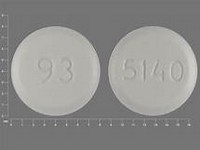Metolazone

CLINICAL USE
Thiazide diuretic, acts synergistically with loop diuretics:Oedema Hypertension
DOSE IN NORMAL RENAL FUNCTION
Oedema: 5–10 mg, increased to 20 mg daily; maximum 80 mg dailyHypertension: 5 mg initially; maintenance: 5 mg on alternate days
PHARMACOKINETICS
Molecular weight :365.8 %Protein binding :95 %Excreted unchanged in urine : 80–95 Volume of distribution (L/kg) :1.6half-life – normal/ESRD (hrs) :8–10/– DOSE IN RENAL IMPAIRMENT
GFR (mL/MIN)
20 to 50 : Dose as in normal renal function 10 to 20 : Dose as in normal renal function <10 : Dose as in normal renal function DOSE IN PATIENTS UNDERGOING RENAL REPLACEMENT THERAPIES
CAPD :Unlikely to be dialysed. Dose as in normal renal function HD :Not dialysed. Dose as in normal renal function HDF/high flux :Unknown dialysability. Dose as in normal renal functionCAV/VVHD :Not Dialysed. Dose as in normal renal function IMPORTANT DRUG INTERACTIONS
Potentially hazardous interactions with other drugsAnalgesics: increased risk of nephrotoxicity with NSAIDs; antagonism of diuretic effectAnti-arrhythmics: hypokalaemia leads to increased cardiac toxicity; effects of lidocaine and mexiletine antagonisedAntibacterials: avoid administration with lymecyclineAntidepressants: increased risk of hypokalaemia with reboxetine; enhanced hypotensive effect with MAOIs; increased risk of postural hypotension with tricyclicsAnti-epileptics: increased risk of hyponatraemia with carbamazepine Antifungals: increased risk of hypokalaemia with amphotericinAntihypertensives: enhanced hypotensive effect; increased risk of first dose hypotension with post-synaptic alpha-blockers like prazosin; hypokalaemia increases risk of ventricular arrhythmias with sotalolAntipsychotics: hypokalaemia increases risk of ventricular arrhythmias with amisulpride or sertindole; enhanced hypotensive effect with phenothiazines; hypokalaemia increases risk of ventricular arrhythmias with pimozide – avoid concomitant useAtomoxetine: hypokalaemia increases risk of ventricular arrhythmiasCardiac glycosides: increased toxicity if hypokalaemia occursCiclosporin: increased risk of nephrotoxicity and possibly hypomagnesaemiaLithium excretion reduced, increased toxicity ADMINISTRATION
Reconstition
– Route
Oral Rate of Administration
–Comments
– OTHER INFORMATION
May result in profound diuresis. Monitor patient’s fluid balance carefullyMonitor for hypokalaemia In patients with creatinine clearance less than 50 mL/minute there is no clinical evidence of accumulation.
See how to identify renal failure stages according to GFR calculation
See how to diagnose irreversible renal disease
Home









